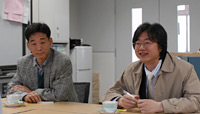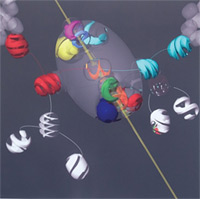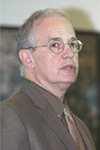 |
|
|
 |
GDE Welcomes Two New Korean Members

Younguk Sohn (left) and
Jinhyuk Choi. |
The Global Design Effort used to have two Korean members, one from Computing in High Energy and Nuclear Physics (CHEP) and the other from Pohang Accelerator Laboratory (PAL). But when a member from PAL moved to CHEP, the GDE recruited two new members, Jinhyuk Choi and Younguk Sohn of PAL, to restore balance.
Choi serves as a division head in an Accelerator Division at PAL. He got his PhD in 1988 at Seoul National University and has been working in accelerator physics ever since. In 2004, Choi started doing ILC related work. "I am mainly responsible for coordination of ILC Korea now. I want to get more involved in the future, because there is a lot of exciting work to do. Furthermore I am thinking of launching a website for ILC Korea to communicate smoothly," Choi says.
Sohn is a senior researcher at PAL. He focuses on RF cavity work and received his degree from Pohang University of Science and Technology (POSTECH) in 1999. "My main role for the GDE is to work with RF cavities, " Sohn says. His ILC career also started in 2004 as a Korean convener of Working Group 5.
Read more...
-- Nobuko Kobayashi |
 |
|
|
 |
Upcoming meetings, conferences, workshops
Polarized Positrons Workshop
POSIPOL 2006
CERN
26-28 April 2006
Linear Collider Forum of America Industrialization Meeting
SLAC
1-2 May 2006
HEP Forum
Cosener's House, UK
6-7 May 2006
European GDE meeting
DESY
10 May 2006 (16:00)
ILC positron source meeting
Budker Institute of Nuclear Physics
BINP, Novosibirk, Russia
10-12 May 2006
Electron Accelerator R&D for the Energy Frontier
LAL Orsay, France
15-17 May 2006
International Accelerator School for Linear Colliders
Sokendai, Graduate School for Advanced Studies
Hayama, Japan
19-27 May 2006
InterAction Meeting on ILC
KEK
29-30 May 2006
ILC Communicators Meeting
KEK
31 May 2006
ILC VTX Workshop at Ringberg
Ringberg Castle, Lake Tegernsee, Germany
28-31 May 2006
Second ATF2 Project Meeting
Japan
30 May-1 June 2006
Second Polarized RF Gun Meeting
SLAC
5 June 2006
CALOR 2006
12th International Conference on Calorimetry in High Energy Physics
Chicago, USA
5-9 June 2006
EPAC '06
Edinburgh, UK
26-30 June 2006
Vancouver Linear Collider Workshop
Vancouver, Canada
19-22 July 2006
ILC GDE Meeting
Vancouver, Canada
19-22 July 2006
Single Crystal Niobium Technology Workshop (pdf)
Araxá mine in Brazil
30 October-1 November 2006
Request Information (email)
ILC GDE Meeting
Valencia, Spain
6-10 November 2006
|
|
 |
 |
|
|
 |
International Linear Collider Takes a Leading Role in EPP2010 Report

EPP2010 Cover Image: Industrial designer Jan-Henrik Anderson, working with particle physicists, portrays the collision of a proton and an anti-proton in the Fermilab Tevatron accelerator. (Courtesy of J-H Anderson) |
At a time when the Large Hadron Collider is scheduled to start up in 2007 and the Tevatron at Fermilab will shut down by the end of this decade, the particle physics program in the United States is at a crossroads. Should the United States fold its cards and determine that the field of particle physics has lost its steam? Or should the United States step up to the plate and prepare to submit a bid to host the next-generation particle accelerator? These are the questions that the National Academies’ National Research Council charged the Committee on Elementary Particle Physics in the 21 st century (EPP2010) to answer, asking the 22-member panel to lay out a 15-year plan. Yesterday on 26 April in the National Academies’ Keck Center in Washington D.C., EPP2010 launched their much-anticipated report, "Revealing the Hidden Nature of Space and Time – Charting the Course for Elementary Particle Physics."
Outlined in priority order as designated by EPP2010, the report recommends that the U.S.:
| 1) |
Fully exploit the opportunities afforded by the construction of the Large Hadron Collider at CERN. |
| |
|
| 2) |
Plan and initiate a comprehensive program to become the world-leading center for research and development on the science and technology of a linear collider, and do what is necessary to be able to mount a compelling bid to build the proposed International Linear Collider on U.S. soil. |
| |
|
| 3) |
Expand the program in particle astrophysics and pursue an international coordinated, staged program in neutrino physics. |
Read more...
Download Report (pdf)
Press Release
-- Elizabeth Clements |
 |
|
|
 |
From Nature
27 April 2006
Making collider endorsement count
A multidisciplinary panel of senior scientists last week endorsed strong US participation in the construction of the International Linear Collider (ILC), the accelerator project that particle physicists see as their top priority. In a report from the National Academy of Sciences, the panel called on the US government to bid to host the ILC...
Read more... (registration required)
From The New York Times
27 April 2006
Physics in America at Crossroads and in Crisis, Panel Says
Physics in America is at a crossroads and in crisis, just as humanity stands on the verge of great discoveries about the nature of matter and the universe, a panel from the National Academy of Sciences said yesterday...
Read more...
From Interactions.org
21 April 2006
Argonne National Laboratory and Fermilab sign collaborative agreement aimed at multi-billion-dollar project; Governor Blagojevich proclaims Illinois Particle Accelerator Day
Two U.S. Department of Energy laboratories, Argonne National Laboratory and Fermi National Accelerator Laboratory, signed a Memorandum of Understanding today to enhance cooperation between the two laboratories on R&D projects...
Read more...
From science@ORF.at
20 April 2006
Stephen Hawkings "Flexiversum"
Stephen Hawking, der Popstar der Kosmologie, hat mit einem Fachkollegen die Geschichte des Universums neu geschrieben - und es bleibt dabei kein Stein auf dem anderen: Nach Ansicht der beiden Physiker müssen wir uns von dem Gedanken verabschieden, dass es dereinst einen Anfang aller Dinge gegeben hat...
Read more...
|
|
 |
 |
|
|
 |
Elementary Particle Physics in the 21st Century

Harold Shapiro |
Creating a roadmap for the future of a scientific field has become a very important planning tool in research areas that require large instruments, such as astronomy and particle physics. This year, two new studies will play a very important role in how particle physics will develop in the future. A planning exercise directed at the future of European particle physics is underway by the CERN Council Strategy Group, and in the U.S. a study called EPP2010 has just been completed and their report was released yesterday.
The much awaited U.S. report is called "Revealing the Hidden Nature of Space and Time : Charting the Course for Elementary Particle Physics." It addresses the future opportunities in particle physics and gives recommendations for the U.S. program, in the context of the worldwide program.
The U.S. report provides a large and welcome boost to our aspirations for the ILC: " The results of the committee's analysis have led to its chief recommendation. The United States should remain globally competitive in elementary particle physics by playing a leading role in the worldwide effort to aggressively study Terascale physics."
They follow by defining the priorities to implement their recommendation that included to " Plan and initiate a comprehensive program to become the world-leading center for research and development on the science and technology of a linear collider, and do what is necessary to mount a compelling bid to build the proposed International Linear Collider on U.S. soil." I hope that this very strong priority statement for the linear collider will be followed by similar priorities statements emerging from Europe and Asia.
Long range planning for high energy physics in the U.S. has traditionally been done through HEPAP, an agency advisory panel. The last such subpanel report, carried out in 2001 and chaired by Jon Bagger (JHU) and myself, helped to establish a TeV scale linear collider as the long term goal of our field, in conjunction with similar reports from Europe and Asia.
Last year, it was decided that planning for the role of elementary particle physics required a different kind of study, one carried out by the U.S. National Academy of Sciences (the "gold standard" for such reports in the US). The objective was to form a very broad committee that would do an overall assessment of the field, its prospects and lay out priorities for its future.
Read more...
--Barry Barish
Director's Corner Archive
|
 |
|
|
 |
ILC NewsLine Survey
If you subscribe to ILC NewsLine, you received a brief survey in your email earlier this week. We really appreciate your feedback and your time in filling out the survey. If you did not receive a survey, please contact newsline@ilcgde.org.
ILC Related Preprints
physics/0604197
24 Apr 2006
Tests Of The Charged Particle Stepper With Muons
hep-ph/0604185
21 Apr 2006
Top Threshold Physics
hep-ph/0604183
21 Apr 2006
Production of Doubly Charged Higgs Bosons at Linear e-e- Colliders
hep-ph/0604180
21 Apr 2006
Indications of the CMSSM Mass Scale from Precision Electroweak Data
|
|